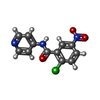[English] 日本語
 Yorodumi
Yorodumi- PDB-8zft: Crystal Structure of Human PPARgamma Ligand Binding Domain in Com... -
+ Open data
Open data
- Basic information
Basic information
| Entry | Database: PDB / ID: 8zft | ||||||
|---|---|---|---|---|---|---|---|
| Title | Crystal Structure of Human PPARgamma Ligand Binding Domain in Complex with T0070907 and SR1664 | ||||||
 Components Components | Peroxisome proliferator-activated receptor gamma | ||||||
 Keywords Keywords | TRANSCRIPTION / Nuclear receptors / TZDs / Drug design / Therapeutic targets | ||||||
| Function / homology |  Function and homology information Function and homology informationprostaglandin receptor activity / : / negative regulation of receptor signaling pathway via STAT / MECP2 regulates transcription factors / negative regulation of vascular endothelial cell proliferation / negative regulation of extracellular matrix assembly / negative regulation of connective tissue replacement involved in inflammatory response wound healing / positive regulation of cholesterol transport / negative regulation of cellular response to transforming growth factor beta stimulus / arachidonate binding ...prostaglandin receptor activity / : / negative regulation of receptor signaling pathway via STAT / MECP2 regulates transcription factors / negative regulation of vascular endothelial cell proliferation / negative regulation of extracellular matrix assembly / negative regulation of connective tissue replacement involved in inflammatory response wound healing / positive regulation of cholesterol transport / negative regulation of cellular response to transforming growth factor beta stimulus / arachidonate binding / positive regulation of adiponectin secretion / negative regulation of cardiac muscle hypertrophy in response to stress / DNA binding domain binding / positive regulation of vascular associated smooth muscle cell apoptotic process / lipoprotein transport / WW domain binding / positive regulation of fatty acid metabolic process / STAT family protein binding / response to lipid / negative regulation of type II interferon-mediated signaling pathway / LBD domain binding / negative regulation of cholesterol storage / negative regulation of SMAD protein signal transduction / lipid homeostasis / E-box binding / alpha-actinin binding / R-SMAD binding / negative regulation of vascular associated smooth muscle cell proliferation / negative regulation of blood vessel endothelial cell migration / monocyte differentiation / white fat cell differentiation / cellular response to low-density lipoprotein particle stimulus / negative regulation of macrophage derived foam cell differentiation / negative regulation of lipid storage / positive regulation of cholesterol efflux / negative regulation of BMP signaling pathway / cell fate commitment / negative regulation of mitochondrial fission / negative regulation of osteoblast differentiation / positive regulation of fat cell differentiation / long-chain fatty acid transport / BMP signaling pathway / nuclear retinoid X receptor binding / Transcriptional regulation of brown and beige adipocyte differentiation by EBF2 / retinoic acid receptor signaling pathway / cell maturation / negative regulation of MAPK cascade / intracellular receptor signaling pathway / hormone-mediated signaling pathway / positive regulation of adipose tissue development / peroxisome proliferator activated receptor signaling pathway / epithelial cell differentiation / regulation of cellular response to insulin stimulus / response to nutrient / peptide binding / negative regulation of miRNA transcription / negative regulation of angiogenesis / placenta development / Regulation of PTEN gene transcription / transcription coregulator binding / positive regulation of apoptotic signaling pathway / SUMOylation of intracellular receptors / negative regulation of smooth muscle cell proliferation / negative regulation of transforming growth factor beta receptor signaling pathway / mRNA transcription by RNA polymerase II / PPARA activates gene expression / fatty acid metabolic process / regulation of circadian rhythm / Transcriptional regulation of white adipocyte differentiation / Nuclear Receptor transcription pathway / positive regulation of miRNA transcription / lipid metabolic process / negative regulation of inflammatory response / DNA-binding transcription repressor activity, RNA polymerase II-specific / regulation of blood pressure / RNA polymerase II transcription regulator complex / nuclear receptor activity / cellular response to insulin stimulus / rhythmic process / glucose homeostasis / MLL4 and MLL3 complexes regulate expression of PPARG target genes in adipogenesis and hepatic steatosis / DNA-binding transcription activator activity, RNA polymerase II-specific / double-stranded DNA binding / cellular response to hypoxia / sequence-specific DNA binding / DNA-binding transcription factor binding / nucleic acid binding / DNA-binding transcription factor activity, RNA polymerase II-specific / cell differentiation / receptor complex / transcription cis-regulatory region binding / RNA polymerase II cis-regulatory region sequence-specific DNA binding / DNA-binding transcription factor activity / negative regulation of gene expression / innate immune response / negative regulation of DNA-templated transcription / intracellular membrane-bounded organelle / chromatin binding / positive regulation of gene expression / regulation of transcription by RNA polymerase II Similarity search - Function | ||||||
| Biological species |  Homo sapiens (human) Homo sapiens (human) | ||||||
| Method |  X-RAY DIFFRACTION / X-RAY DIFFRACTION /  SYNCHROTRON / SYNCHROTRON /  MOLECULAR REPLACEMENT / Resolution: 3.2 Å MOLECULAR REPLACEMENT / Resolution: 3.2 Å | ||||||
 Authors Authors | Shang, J. / Kojetin, D.J. | ||||||
| Funding support |  United States, 1items United States, 1items
| ||||||
 Citation Citation |  Journal: Elife / Year: 2024 Journal: Elife / Year: 2024Title: Unanticipated mechanisms of covalent inhibitor and synthetic ligand cobinding to PPAR gamma. Authors: Shang, J. / Kojetin, D.J. #1:  Journal: Elife / Year: 2024 Journal: Elife / Year: 2024Title: Unanticipated mechanisms of covalent inhibitor and synthetic ligand cobinding to PPAR gamma. Authors: Shang, J. / Kojetin, D.J. | ||||||
| History |
|
- Structure visualization
Structure visualization
| Structure viewer | Molecule:  Molmil Molmil Jmol/JSmol Jmol/JSmol |
|---|
- Downloads & links
Downloads & links
- Download
Download
| PDBx/mmCIF format |  8zft.cif.gz 8zft.cif.gz | 115.4 KB | Display |  PDBx/mmCIF format PDBx/mmCIF format |
|---|---|---|---|---|
| PDB format |  pdb8zft.ent.gz pdb8zft.ent.gz | 88.4 KB | Display |  PDB format PDB format |
| PDBx/mmJSON format |  8zft.json.gz 8zft.json.gz | Tree view |  PDBx/mmJSON format PDBx/mmJSON format | |
| Others |  Other downloads Other downloads |
-Validation report
| Summary document |  8zft_validation.pdf.gz 8zft_validation.pdf.gz | 1.4 MB | Display |  wwPDB validaton report wwPDB validaton report |
|---|---|---|---|---|
| Full document |  8zft_full_validation.pdf.gz 8zft_full_validation.pdf.gz | 1.4 MB | Display | |
| Data in XML |  8zft_validation.xml.gz 8zft_validation.xml.gz | 23 KB | Display | |
| Data in CIF |  8zft_validation.cif.gz 8zft_validation.cif.gz | 29.9 KB | Display | |
| Arichive directory |  https://data.pdbj.org/pub/pdb/validation_reports/zf/8zft https://data.pdbj.org/pub/pdb/validation_reports/zf/8zft ftp://data.pdbj.org/pub/pdb/validation_reports/zf/8zft ftp://data.pdbj.org/pub/pdb/validation_reports/zf/8zft | HTTPS FTP |
-Related structure data
| Related structure data | 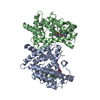 8zfnC 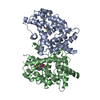 8zfoC 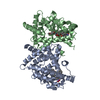 8zfpC 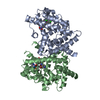 8zfqC 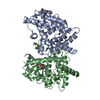 8zfrC 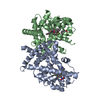 8zfsC C: citing same article ( |
|---|---|
| Similar structure data | Similarity search - Function & homology  F&H Search F&H Search |
- Links
Links
- Assembly
Assembly
| Deposited unit | 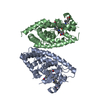
| ||||||||
|---|---|---|---|---|---|---|---|---|---|
| 1 | 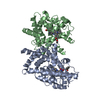
| ||||||||
| Unit cell |
|
- Components
Components
| #1: Protein | Mass: 31449.520 Da / Num. of mol.: 2 Source method: isolated from a genetically manipulated source Source: (gene. exp.)  Homo sapiens (human) / Gene: PPARG, NR1C3 / Plasmid: pET46 / Production host: Homo sapiens (human) / Gene: PPARG, NR1C3 / Plasmid: pET46 / Production host:  #2: Chemical | #3: Chemical | Has ligand of interest | Y | Has protein modification | Y | |
|---|
-Experimental details
-Experiment
| Experiment | Method:  X-RAY DIFFRACTION / Number of used crystals: 1 X-RAY DIFFRACTION / Number of used crystals: 1 |
|---|
- Sample preparation
Sample preparation
| Crystal | Density Matthews: 2.76 Å3/Da / Density % sol: 55.5 % |
|---|---|
| Crystal grow | Temperature: 293 K / Method: vapor diffusion, sitting drop / Details: 0.8M SODIUM CITRATE, 100mM MOPS, pH 7.6 |
-Data collection
| Diffraction | Mean temperature: 100 K / Serial crystal experiment: N |
|---|---|
| Diffraction source | Source:  SYNCHROTRON / Site: SYNCHROTRON / Site:  ALS ALS  / Beamline: 5.0.2 / Wavelength: 0.97741 Å / Beamline: 5.0.2 / Wavelength: 0.97741 Å |
| Detector | Type: DECTRIS PILATUS3 6M / Detector: PIXEL / Date: Aug 16, 2017 |
| Radiation | Monochromator: Double-crystal, Si(111) / Protocol: SINGLE WAVELENGTH / Monochromatic (M) / Laue (L): M / Scattering type: x-ray |
| Radiation wavelength | Wavelength: 0.97741 Å / Relative weight: 1 |
| Reflection | Resolution: 3.2→59.095 Å / Num. obs: 11555 / % possible obs: 99.87 % / Redundancy: 2 % / CC1/2: 0.995 / Net I/σ(I): 10.7 |
| Reflection shell | Resolution: 3.2→3.314 Å / Redundancy: 2 % / Num. unique obs: 1163 / CC1/2: 0.809 / % possible all: 100 |
- Processing
Processing
| Software |
| |||||||||||||||||||||||||||||||||||||||||||||
|---|---|---|---|---|---|---|---|---|---|---|---|---|---|---|---|---|---|---|---|---|---|---|---|---|---|---|---|---|---|---|---|---|---|---|---|---|---|---|---|---|---|---|---|---|---|---|
| Refinement | Method to determine structure:  MOLECULAR REPLACEMENT / Resolution: 3.2→59.095 Å / SU ML: 0.53 / Cross valid method: THROUGHOUT / σ(F): 1.34 / Phase error: 32.73 / Stereochemistry target values: ML MOLECULAR REPLACEMENT / Resolution: 3.2→59.095 Å / SU ML: 0.53 / Cross valid method: THROUGHOUT / σ(F): 1.34 / Phase error: 32.73 / Stereochemistry target values: ML
| |||||||||||||||||||||||||||||||||||||||||||||
| Solvent computation | Shrinkage radii: 0.9 Å / VDW probe radii: 1.11 Å / Solvent model: FLAT BULK SOLVENT MODEL | |||||||||||||||||||||||||||||||||||||||||||||
| Displacement parameters | Biso max: 148.96 Å2 / Biso mean: 80.4146 Å2 / Biso min: 36.28 Å2 | |||||||||||||||||||||||||||||||||||||||||||||
| Refinement step | Cycle: final / Resolution: 3.2→59.095 Å
| |||||||||||||||||||||||||||||||||||||||||||||
| Refine LS restraints |
| |||||||||||||||||||||||||||||||||||||||||||||
| LS refinement shell | Refine-ID: X-RAY DIFFRACTION / Rfactor Rfree error: 0 / % reflection obs: 100 %
|
 Movie
Movie Controller
Controller


 PDBj
PDBj